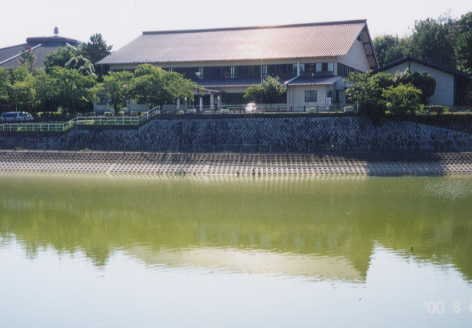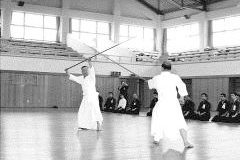Written by Kagita Chūbee, 20th sōke of the Hōzōinryū
The Return of the Hōzōinryū Sōjutsu to Nara
There is a mysterious relationship between the Hōzōinryū Sōjutsu and the family Kagita. In the year Shōwa 33 (1958) my late father Chūzaburō constructed the first toll highway in Japan which lead through the Kōenzan, a mountain in the west of Nara. One feeding road to this highway was built next to the cemetary of the temple Byakugōji. On this occasion my father discovered the tombs of Hōzōin Kakuzenbō Inei an his successors. This was the beginning of the previously mentioned relationship.
From that point on my father watched over the tombs and paid them his respect. One night a monk clad in violet appeared in my father's dreams, communicating something urgently but wordless. My father, who had been paralyzed by this apparition, suddenly jumped up, letting out a loud cry, "eyh!" and opened his eyes. On the same day he visited Inei's grave. Rain seemed imminent when he said his prayers in the dark. Then suddenly the same monk reappeared and my father knew that he must be Hōzōin Inei. My father wondered whether the monk in his dream hadn't put a task on him.

The Nara Central Dōjō for Martial Arts.In Shōwa 48 (1973) when my father was mayor of Nara an spilled his heartblood to develop the city he built the Nara Central Dōjō for Martial Arts1 which, at a size of 400 jō2, was the largest municipal dōjō in Japan at that time. During the construction he invited Ishida Kazuto3, president of the All Japan Kendō Federation (and former president of the Supreme Court) to have a look at the dōjō. When my father explained to him that the the dōjō was sized so that even sōjutsu training was possible, Ishida Kazuto seemed to be interested. So my father took him to the grave of Hōzōin Inei. Afert they'd recited the Hannya Shingyō4 Ishida Kazuto humbly said: "Actually I know a little about the forms of the Hōzōinryū Takadaha Sōjutsu." To my father's surprise it turned out that Ishida Kazuto was the current headmaster of the Hōzōinryū Sōjutsu. My father asked him to give a spear demonstration at the official opening of Nara Central Dōjō for Martial Arts on September 28th in the year Shōwa 49 (1974). On that day Ishida Kazuto performed the forms of the Hōzōinryū Takadaha Sōjutsu together with Sakanishi Tarō and Yamazaki Suguru.

Ishida Kazuto and Nishikawa Gennai.Deeply impressed by this fantastic demonstration my father beseeched Ishida Kazuto to let the Hōzōinryū Sōjutsu return to its hometown Nara and to teach it there. Ishida Kazuto understood my father's enthusiasm and gladly met his request. Not only did he teach swordsmen from Nara in Tōkyō but often he himself came to Nara where we absorbed his teachings ardently. Finally the headmastership was transferred from the 18th Sōke of the Hōzōinryū Takadaha Sōjutsu to Nishikawa Gennai, Kendō 8th dan Hanshi5, in a ceremony at the Nara Central Dōjō for Martial Arts in February of the year Shōwa 51 (1976). Thus the Hōzōinryū Sōjutsu, which had completely disappeared from Nara due to the anti-Buddhistic movement during the Meiji period6, awoke to new life in its birthplace and grew roots there once again. Thus it happened that we could take up spear training there.
In May of Shōwa 54 (1979) Ishida Kazuto unexpectedly passed away. If he hadn't come to Nara and if my father hadn't visited Inei's Grave with him at that time, the Hōzōinryū Sōjutsu probably would have disappeard with him for all time. Bearing this in mind I am even more grateful for our historic good fortune.
Since (the return of the school to Nara) we trained zealously (in Hōzōinryū Sōjutsu) until in June of the year Heisei 3 (1991) I was appointed his successor and 20th Sōke by Nishikawa Gennai, a position I am stll holding today.
(First published in the Nara town magazine Ubusuna on September 5th 2009)
Nara-shi chūō budōjō
1. 1 jō equals the space taken by 1 tatami mat, which is 182 cm by 91 cm. So 400 jō equal to 662,5 m2. This is the trainig space only!
2. 1903 - 1979. Ishida Kazuto was the 5th headmaster of the sword style Ittō Shōden Mutōryū as well.
3. The Heart Sutra.
4. Hanshi, master, ist the highest modern teaching rank in disciplines like Kendō, Iaidō, or Kyūdō.
5. 1868 - 1912
